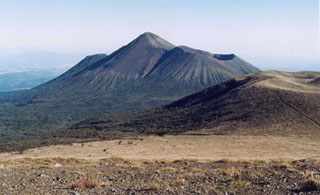Report on Kirishimayama (Japan) — 2 February-8 February 2011
Smithsonian Institution / US Geological Survey
Weekly Volcanic Activity Report, 2 February-8 February 2011
Managing Editor: Sally Sennert.
Please cite this report as:
Global Volcanism Program, 2011. Report on Kirishimayama (Japan) (Sennert, S, ed.). Weekly Volcanic Activity Report, 2 February-8 February 2011. Smithsonian Institution and US Geological Survey.
Kirishimayama
Japan
31.934°N, 130.862°E; summit elev. 1700 m
All times are local (unless otherwise noted)
According to a news article, explosions on 2 February from Shinmoe-dake (Shinmoe peak), a stratovolcano of the Kirishima volcano group, disrupted flights to Tokyo. The article also noted that JMA widened the restricted zone to a 4-km-radius around the crater. About 600 people from Miyazaki (55 km E) had evacuated.
Based on reports from JMA, analyses of satellite imagery, and pilot observations, the Tokyo VAAC reported that during 2-8 February ash plumes rose to altitudes of 1.5-4.6 km (5,000-15,000 ft) a.s.l. and drifted SE. On 3 February, a pilot noted that an ash plume rose to an altitude of 9.1 km (30,000 ft) a.s.l. and drifted NE.
According to JMA, scientists observed Shinmoe-dake during an overflight on 6 February and noted that the lava dome was about 600 m in diameter, similar to observations from four days prior. Gas plumes rose from the edges of the lava dome, from multiple areas on the E side of the dome, and from a central vent. Ash plumes rose 1.5 km above the crater rim and drifted SE.
Geological Summary. Kirishimayama is a large group of more than 20 Quaternary volcanoes located north of Kagoshima Bay. The late-Pleistocene to Holocene dominantly andesitic group consists of stratovolcanoes, pyroclastic cones, maars, and underlying shield volcanoes located over an area of 20 x 30 km. The larger stratovolcanoes are scattered throughout the field, with the centrally located Karakunidake being the highest. Onamiike and Miike, the two largest maars, are located SW of Karakunidake and at its far eastern end, respectively. Holocene eruptions have been concentrated along an E-W line of vents from Miike to Ohachi, and at Shinmoedake to the NE. Frequent small-to-moderate explosive eruptions have been recorded since the 8th century.
Sources: Volcano Research Center-Earthquake Research Institute (University of Tokyo), Asia One, Japan Meteorological Agency (JMA), Tokyo Volcanic Ash Advisory Center (VAAC)

